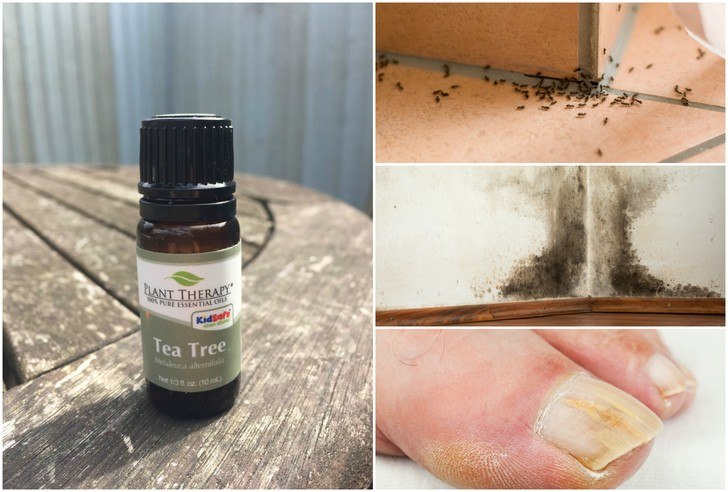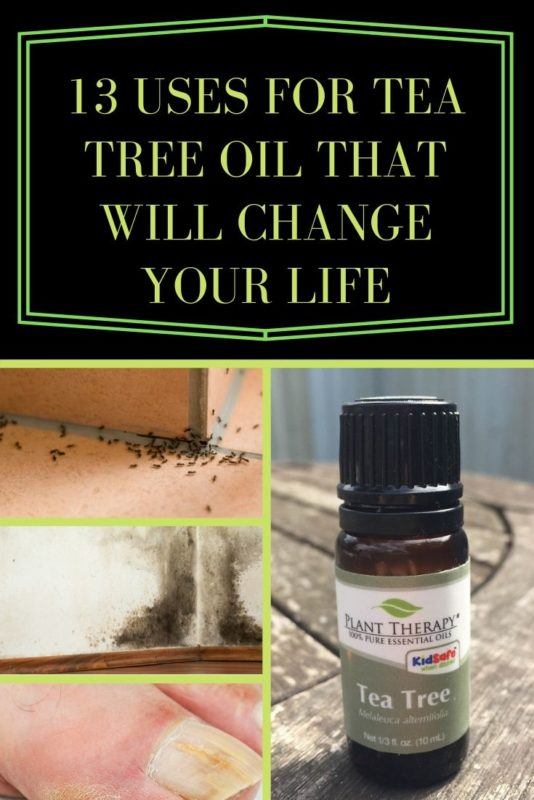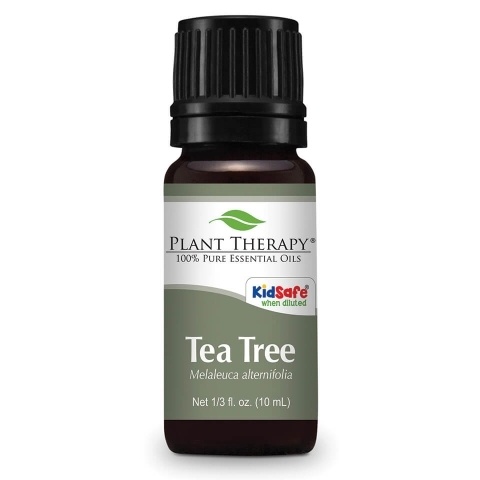
Not to be confused with an extract of the tea plant (Camellia sinensus), tea tree oil is distilled from the leaves of the Australian tea tree (Melalenca alternifolia.) Although it is highly toxic when ingested, thanks to its antibiotic, anti-fungal, antiseptic, expectorant and antiviral properties, tea tree oil has a surprising number of topical uses which can help cure or prevent a whole host of everyday maladies, which is why it is often referred to as a “medicine cabinet in a bottle.”
Let’s take an in-depth look at just some of the ways having a bottle of tea tree oil in your home can literally change your life, but first let’s discuss tea tree oil safety.
Tea Tree Oil Safety
The main safety consideration with tea tree oil is skin irritation. While tea tree oil is generally considered one of the safer essential oils for undiluted use on skin, those with sensitive skin should dilute it with a carrier oil – such as sweet almond, olive or coconut oil. Before using tea tree oil undiluted, undertake a skin patch test. Never take tea tree oil internally.
13 Tea Tree Oil Uses That Will Change Your Life
1. Topical Antiseptic to Treat Wounds and Infections
The terpenes in tea tree oil give this versatile substance antiseptic properties that make it especially powerful for healing wounds and battling an infection. It’s even been shown in scientific research published in the Journal of Investigative Dermatology in 2006 to be effective at fighting the super-bug MRSA, which is a strain of staph bacteria that is resistant to many common antibiotics. For this reason, it’s often used as a natural remedy to prevent infection in small wounds, blisters, and burns.
2. Acne Treatment
Tea tree oil’s antimicrobial terpenes content also makes it popular for combating acne. Not only does it kill MRSA or staph infections, but it will also kill Propionibacterium acnes that live inside hair follicles and can lead to inflammation and acne. The oil also contains soothing properties that help to calm the burning and itching of a flare-up.
A gel composed of 5% tea tree oil, when applied to affected areas has been shown in studies to be as effective as an identical dose of benzoyl peroxide. Treatment takes a bit longer with tea tree oil, but this natural acne remedy is also proven to be less damaging to skin. You can even make your own inexpensive DIY tea tree oil acne face wash by combining five drops of pure tea tree oil with two teaspoons of raw honey. Gently rub the mixture onto your face, leave it on for about a minute, and then rinse with cool water.
3. Nail Fungus
Tea tree oil has the ability to kill parasites and fungal infections, which is why it’s so popular for use in fighting toenail fungus, ringworm and athlete’s foot. In fact, it’s been proven to work just as well as over-the-counter chemical treatments in studies. Apply undiluted tea tree oil twice daily to affected areas like nails or feet to relieve symptoms, and possibly completely heal these unsightly ailments. If the problem is extra stubborn, you may want to mix it with oregano essential oil which is also a potent antifungal. It has been proven in medical studies to kill off candidiasis, that bacteria or fungus that can grow within your system.
Read More: Top 10 Best Home Remedies For Toenail Fungus
4. Eliminate Ringworm
Ringworm is a fungal infection of the skin caused by exposure to the fungus tinea. It is highly contagious and can be spread through contact with infected people, animals, or items. Tea tree oil has been noted in a medical study in the August 2002 issue of the Australasian Journal of Dermatology as being an effective treatment for ringworm, curing the fungus after four weeks of treatment in more than 64 percent of test subjects. The oil’s antifungal properties make it effective for both treating ringworm and preventing it from spreading.
Apply 2-3 drops pure tea tree oil diluted in a carrier oil two or three times per day to treat skin that’s been infected with ringworm. Be sure to clean any personal items that may have come in contact with the fungus by using a tea tree cleanser to prevent further spread of infection.
Read More: 10 Amazing Ways Tea Tree Oil Works Wonders For Your Skin
5. Eliminate Foot Odor
You can keep your feet smelling nice by making a homemade foot powder with tea tree oil. Mix up one-quarter cup cornstarch, one-quarter cup baking soda and 10 drops each tea tree oil and lavender oil. Powder your feet and the insides of your shoes and you’ll keep that foot odor at bay.
6. Scalp and Hair Health
Tea tree oil has proven to be very beneficial for the health of both your scalp and hair. It’s often used as a non-drying, non-damaging alternative to harsh chemical dandruff shampoos. In fact, some say tea tree oil just might be the miracle cure for itchy, flaky scalp. That’s because it has the ability to eliminate dandruff and soothe dry flaking skin.
Even if you don’t suffer from dandruff, you can suffer from an itchy scalp – that’s not only extremely irritating, but it can lead to other problems like hair loss. An itchy scalp is often caused by a fungus, bacteria or an allergic reaction, and as tea tree oil has been proven to fight these problems, it can be incredibly effective. It may even be able to help cure scalp eczema and scalp folliculitis too.
There are numerous ways to make your own tea tree oil shampoo to treat these issues that can be found, including in this guide, or you can simply mix a few drops of tea tree essential oil with aloe vera gel, coconut milk and a couple of drops of lavender oil.
7. Head Lice
When mixed with peppermint oil, tea tree oil has been shown to repel head lice in young children. Treatment with tea tree oil is also an effective natural treatment to eliminate lice already present on a host. While it is useful against parasites on people, tea tree oil is not recommended for treatment of pets as the toxins present in the oil present a high risk of negative side-effects in smaller animals.
If you’ve ever dealt with head lice, you know what a huge problem it can be, so it’s good news that there has been some scientific research that has suggested tea tree oil can be an effective treatment. One 2012 study, in particular, published in Parasitology Research, found that tea tree oil may be able to kill lice in the nymph and adult stages of life, as well as reduce the number of lice eggs that hatch. Research conducted in 2010 out of the University of Queensland in Australia and published in BMC Dermatology, also discovered rather promising results. Experts treated children suffering from head lice with various treatments, including a tea tree and lavender oil treatment. Just one-quarter of those treated with a chemical anti-lice shampoo containing piperonyl butoxide and pyrethrins were free of lice afterward; however, nearly all of the kids treated with the tea tree oil solution were totally lice-free.
It works to eliminate lice because tea tree oil contains two elements known for their insecticidal properties that help kill lice: 1,8-cineole and terpinen-4-ol. In addition, the oil helps to remove nits or lice eggs as it can dissolve the gummy texture that connects the nits to the hair shaft, making them easy to remove when combing the hair.
Read More: 4 Reasons You Should Put Tea Tree Oil On Your Hair
8. Sore Throat Treatment
Tea tree oil diluted in water is also a great natural remedy for a sore throat. A sore throat is caused by a viral or bacterial infection that also causes a cold or the flu. These viruses and bacteria cause inflammation of the mucous membranes and contribute to a sore throat. A tea tree oil gargle is enough to soothe the inflammation and relieve the pain. It’s especially effective when used at the first sign of throat pain or a cold, to prevent it from becoming worse.
One of the best ways to use tea tree for a sore throat is to breathe in the steam. To do so, add a few drops of tea tree oil to boiling water, and then lower your face toward the vapors, keeping a towel draped over the back of your head and around the sides of the pot to help trap the steam. Inhale the vapors, breathing deeply for 5 to 10 minutes. Afterward, not only will your throat feel better, but the treatment will help clear up any sinus or chest congestion too. Alternatively, you can gargle with it like you would a mouth rinse by warming up a glass of water, adding a couple drops of tea tree oil and mixing it in; gargle for 30 seconds to one minute, and then spit it out. Repeat either method twice each day to kill bacteria and relieve soreness, until all symptoms are gone.
As mentioned, be extra careful not to swallow any tea tree oil as it is toxic when ingested.
9. Oral Health
Because tea tree oil has the ability to kill off bad bacteria while soothing inflamed skin at the same time, it’s the ideal ingredient to use in a homemade mouthwash or toothpaste. It’s also been found to reduce gum bleeding and tooth decay. The Tea Tree Group out of Australia has been responsible for many of the positive studies on tea tree oil, including one in which Dr. Kate Hammer found that a range of oral bacteria, which is responsible for tooth decay, was susceptible to tea tree oil even at a low dilution.
Tea tree oil especially effective for those who are prone to fungal or bacterial oral infections when used as a natural mouth rinse. Just be sure that you don’t swallow tea tree oil as the toxic compounds it contains can cause nausea, disorientation, and in some severe cases, even coma.
You can add a drop of undiluted tea tree oil to your toothpaste right before brushing to support better oral health, or you can put together a DIY toothpaste simply by mixing tea tree oil with coconut oil and baking soda. All you need to do is combine a quarter cup coconut oil with one to two tablespoons of baking soda and 10 drops of tea tree oil and use it like you would any toothpaste.
10. Insect Bites and Stings
Tea tree oil works incredibly well for treating mosquito and other insect bites and stings. It disinfects as well as helping to bring down any swelling. Apply tea tree oil diluted in a carrier oil liberally to affected areas to disinfect the wound, lessen pain, and prevent itching. Keep the wound covered with a bandage to keep the oil from evaporating, and repeat once or twice per day until the bite or sting is healed.
11. Pest Control
Not only is tea tree oil great for treating those bug bites and stings, it’s also good at keeping the insects away, or even killing them. The oil’s anti-parasitic properties make it capable of destroying or suppressing the growth of parasites like fleas, leeches, lice, and ticks. Plus it can repel mosquitoes, ants, spiders and more.
If you’re trying to keep the biting critters out of your home, you can douse cotton balls in the oil and place them strategically throughout your house. Or, when you want to enjoy a meal on your outdoor patio, simply mix a few drops in a spray bottle with water and spray it evenly across your body to prevent mosquitoes and other bugs from coming near you. If you have garbage cans outside, they can be a major attract for flies, which can get into your house and your garden. You can repel them with tea tree oil too. Simply sponge the sides of the upper portions of your garbage cans with some tea tree oil and those flies will “magically” disappear.
12. Household Cleaner
The same antimicrobial abilities that make tea tree oil so effective for clearing up infections in the body also make it an amazing household cleaner that will kill off any bacteria you have lying around your home.
- Make an all-purpose cleaner. In a 1-quart glass spray bottle, add 10 drops of tea tree oil to two cups hot water and a half-cup vinegar. Use it to clean counters, mirrors, fixtures, throughout your bathroom and more.
- An air freshener. Make your own natural deodorizer so that your house smells amazing by combining a cup of distilled water, 3 drops tea tree oil and 2 drops of lemon essential oil in a spray bottle. Shake the bottle before each use to evenly distribute the scented oil throughout the water, and then use the fine mist setting on your bottle to distribute the spray evenly through the air.
- Laundry cleaning booster. In order to boost the cleaning power of your laundry detergent as well as to help prevent bacteria and fungal infections from extra dirty clothes, simply add 10 drops of tea tree oil to your wash.
- Fight mold and mildew. Combine a teaspoon of tea tree oil with one cup of water in a spray bottle and then shake well to combine. You can use it to treat existing areas of mold. By leaving it on for several minutes before wiping away, or use it as a preventative by spraying where the problem might occur, such as shower curtains, the dishwasher or toilet bowl. You might also use consider buying a diffuser and diffusing tea tree oil in the air around your home to kill mold and other bad bacteria.
- Bathroom scrub. For tough bathroom cleaning, you can make your own scrub by adding 10 to 15 drops of tea tree oil to a mixture of water, vinegar, baking soda and castile soap. The baking soda lifts stains, while the tea tree oil boosts the cleaning powers of vinegar to fight bacteria and mold.
13. Help Your Garden Thrive
Most components of tea tree oil are known to be active against a wide range of fungi, like terpinen-4-ol, the most active agent in the oil we’ve mentioned previously. A study published in April 2007 in Letters in Applied Microbiology showed that tea tree oil was effective at fighting the fungi that cause Fusarium head blight in wheat, barley, and oats, as well as barley leaf stripe and powdery mildew. Other research has demonstrated that the oil is beneficial for controlling problems like leather rot in strawberries, fruit rots, early blight disease in tomato plants, cercospora beticola on sugar beets and alternaria solani on potatoes.
You can prevent fungal growth on your own plants and leaves by combining 2 tablespoons of tea tree oil with 2 cups of water in a spray bottle and spraying plants with the solution every 3 to 7 days. Tea tree oil can also repel whiteflies that excrete a sticky dew that causes sooty mold fungi to grow on foliage. It’s best to spray in the morning, and less frequently during any hot, dry spells in order to avoid burning leaves that are treated with the oil.
Future infections can be prevented by removing infected plant materials and leaves around plants and disposing them in the garbage to avoid spreading disease. Tea tree oil comes into play once again, as it makes a great solution for disinfecting any tools you might use to cut any diseased wood or other materials. Simply dip them into a tea tree oil solution to disinfect.
Read More: 9 Genius Uses For Essential Oils In The Garden
Where To Buy Tea Tree Oil
Tea tree oil is one of the more abundant, and therefore affordable, essential oils meaning everyone can (and should) have a bottle in their home.
When buying tea tree oil look for a brand that is 100% pure, free from additives, adulterants and dilutions. We strongly recommend Plant Therapy Essential Oils for their high quality oils at affordable prices.
You can purchase a 10ml bottle of 100% Pure Organic Tea Tree Oil from this page on their official website. Or if you already know how much you love tea tree oil, perhaps consider opting for this much larger 100ml bottle.
Plant Therapy Essential Oils are also available on Amazon.
Pin This To Save For Later


